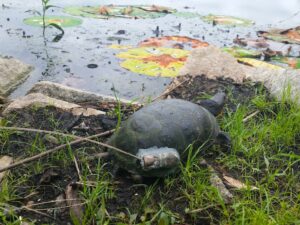We often talk about protecting turtle nests, but how does it actually happen? Finding a turtle nest is no mean feat; the animals work hard to hide their nesting activity, because many other animals would like nothing better than a turtle egg buffet. Our team works day and night (literally) during turtle nesting season to find as many nests as possible – read on to learn more about how we do it!

The first step comes when we catch an adult female turtle. We attach a small radio to her shell that sends out a continuous beeping signal. These radios and the special epoxy we use to attach them are kept within strict weight limits, to avoid putting extra strain on the turtles as they go about their lives. We use a special receiver to track the radio signals, which we then hear as a consistent beep. By pointing a directional antenna, we can determine by the volume of the beeping whether we’re getting closer to a radio (and its turtle) or farther away. From there, it’s like a giant game of Marco Polo, with our staff following their ears to find where the turtles are hiding.

Once we find a turtle, we assess whether that turtle is in “nesting habitat.” For aquatic turtles like Blanding’s, this is pretty straightforward – Blanding’s turtles nearly always nest in the evening, and if they’re not looking for a place to nest, they’re usually resting in the water. A turtle in the water isn’t in nesting habitat. For other turtles, it’s a trickier matter – wood turtles spend more time on land than Blanding’s do, and they can nest any time of day. Box turtles, of course, spend almost all their time on land to begin with. This is where our staff’s extensive experience with the turtles comes into play. Many of our staff have been working with these turtle populations for multiple years, and they know where each individual tends to spend time and how far they’re likely to move in a day. Sudden large movements away from a favorite haunt are often an indicator that a turtle is looking for somewhere to nest.
When we find a turtle that seems to be in nesting habitat and is looking for a spot to nest, we follow from a discreet distance to avoid “spooking” the animal – as previously mentioned, turtles want to hide their nests, and aren’t likely to feel secure digging with a large ape standing ten feet behind and staring at them. Just because a turtle seems to be looking for a nest site doesn’t mean she will nest; many turtles will “false start” or simply wander around for several nights without laying before they actually commit. Our team has no way of knowing when a turtle will finally lay her clutch, so we organize into teams to follow turtles acting suspiciously and stay in communication. Most of this work is done from streets, conservation areas, and public rights-of-way; once the turtle crosses onto private property, we seek landowner permission to follow them.

After all this work, we are (occasionally) in the right place at the right time to watch a turtle lay her eggs and protect the nest with a metal screen to keep predators out. These are the moments that make it all worthwhile!
